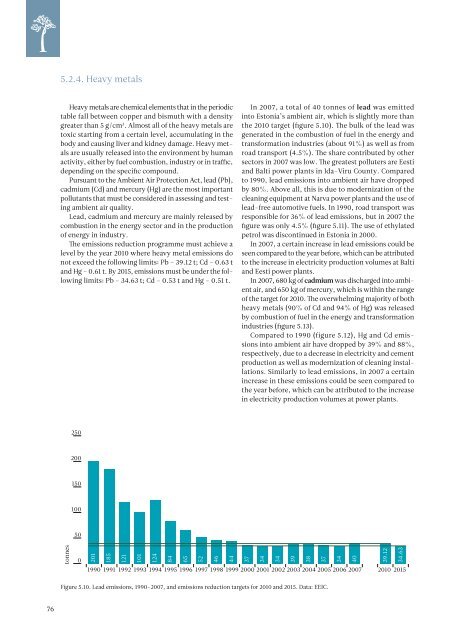ESTONIAN ENVIRONMENTAL REVIEW 2009
ESTONIAN ENVIRONMENTAL REVIEW 2009
ESTONIAN ENVIRONMENTAL REVIEW 2009
You also want an ePaper? Increase the reach of your titles
YUMPU automatically turns print PDFs into web optimized ePapers that Google loves.
5.2.4. Heavy metals<br />
Heavy metals are chemical elements that in the periodic<br />
table fall between copper and bismuth with a density<br />
greater than 5 g/cm 3 . Almost all of the heavy metals are<br />
toxic starting from a certain level, accumulating in the<br />
body and causing liver and kidney damage. Heavy metals<br />
are usually released into the environment by human<br />
activity, either by fuel combustion, industry or in traffic,<br />
depending on the specific compound.<br />
Pursuant to the Ambient Air Protection Act, lead (Pb),<br />
cadmium (Cd) and mercury (Hg) are the most important<br />
pollutants that must be considered in assessing and testing<br />
ambient air quality.<br />
Lead, cadmium and mercury are mainly released by<br />
combustion in the energy sector and in the production<br />
of energy in industry.<br />
The emissions reduction programme must achieve a<br />
level by the year 2010 where heavy metal emissions do<br />
not exceed the following limits: Pb – 39.12 t; Cd – 0.63 t<br />
and Hg – 0.61 t. By 2015, emissions must be under the following<br />
limits: Pb – 34.63 t; Cd – 0.53 t and Hg – 0.51 t.<br />
In 2007, a total of 40 tonnes of lead was emitted<br />
into Estonia’s ambient air, which is slightly more than<br />
the 2010 target (figure 5.10). The bulk of the lead was<br />
generated in the combustion of fuel in the energy and<br />
transformation industries (about 91%) as well as from<br />
road transport (4.5%). The share contributed by other<br />
sectors in 2007 was low. The greatest polluters are Eesti<br />
and Balti power plants in Ida-Viru County. Compared<br />
to 1990, lead emissions into ambient air have dropped<br />
by 80%. Above all, this is due to modernization of the<br />
cleaning equipment at Narva power plants and the use of<br />
lead-free automotive fuels. In 1990, road transport was<br />
responsible for 36% of lead emissions, but in 2007 the<br />
figure was only 4.5% (figure 5.11). The use of ethylated<br />
petrol was discontinued in Estonia in 2000.<br />
In 2007, a certain increase in lead emissions could be<br />
seen compared to the year before, which can be attributed<br />
to the increase in electricity production volumes at Balti<br />
and Eesti power plants.<br />
In 2007, 680 kg of cadmium was discharged into ambient<br />
air, and 650 kg of mercury, which is within the range<br />
of the target for 2010. The overwhelming majority of both<br />
heavy metals (90% of Cd and 94% of Hg) was released<br />
by combustion of fuel in the energy and transformation<br />
industries (figure 5.13).<br />
Compared to 1990 (figure 5.12), Hg and Cd emissions<br />
into ambient air have dropped by 39% and 88%,<br />
respectively, due to a decrease in electricity and cement<br />
production as well as modernization of cleaning installations.<br />
Similarly to lead emissions, in 2007 a certain<br />
increase in these emissions could be seen compared to<br />
the year before, which can be attributed to the increase<br />
in electricity production volumes at power plants.<br />
250<br />
200<br />
150<br />
100<br />
50<br />
tonnes<br />
0<br />
201<br />
185<br />
121<br />
101<br />
124<br />
84<br />
65<br />
52<br />
46<br />
44<br />
37<br />
34<br />
34<br />
39<br />
38<br />
37<br />
34<br />
40<br />
39.12<br />
34.63<br />
1990 1991 1992 1993 1994 1995 1996 1997 1998 1999 2000 2001 2002 2003 2004 2005 2006 2007 2010 2015<br />
Figure 5.10. Lead emissions, 1990–2007, and emissions reduction targets for 2010 and 2015. Data: EEIC.<br />
76

















